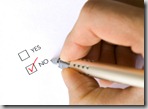 Do you constantly say “yes” to all the wrong things, leaving you absolutely no time or energy when the right opportunities come along?
Do you constantly say “yes” to all the wrong things, leaving you absolutely no time or energy when the right opportunities come along?
If you’re an entrepreneur and you can’t relate to this, I’d love to meet you.
We all worry about saying “no” to business, partnerships and even advertising opportunities. What if this is my one chance to attract a boatload of customers? What if this is the only client I get this quarter? That old adage, “A bird in the hand is worth two in the bush” is definitely a truism…..sometimes.
If you constantly accept clients who don’t fit your ideal profile or the type of work you want to be doing, how can you free yourself up to attract a better, more profitable client for the long run? Understanding your brand in clear detail will help you determine if someone is a good fit. It will help you say no to marketing opportunities that seem seductive at first (“Wow! This event attracts 5000 women!”) but in reality, turn out to be a waste of time and money (“Oh, those 5000 women will never be the ones who will buy from me!”)
As I learned to adapt to my new reality post-brain injury, I couldn’t say yes to as much as I would have in the past. I had to be selective in which clients I accepted and how I spent my time. This meant turning down some work that, while intriguing and interesting, was not going to be a good fit for me. And you can do this in an elegant and tactful way. You can explain that you don’t have bandwidth right now with your current client load, or you can recommend another resource that might be a better fit for their needs. With partners, you can gently say the opportunity looks fabulous but you think you might be going after different target markets. With an advertising opportunity – well, this is business after all, and you can simply say, “We don’t see this as a valuable way to spend out money, but thank you for thinking of us.”
Remember, your clients and partners say something about your brand. They are your advertising.
By focusing on what you want, what you’re good at and what you can realistically deliver, people will appreciate your honesty more than they’ll appreciate you not having the time or mental energy to properly serve their needs.
View the juicy video for Lesson #5 here.
How do you determine which work to take on and which to pass up? Any tips or fun stories about times you have turned down opportunities?
BACKSTORY TO THE SEVEN LESSONS: What do recovering from a brain aneurysm and branding have in common? Quite a bit, it turns out. Recently, I got the wonderful opportunity to share my dramatic story at a Women Business Owners luncheon and I promised I’d post the lessons here for everyone. This is a seven-post series.
Lesson #1: Focus (and backstory to the series)



